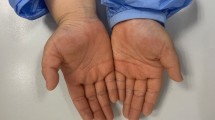Abstract
Allergic contact dermatitis (ACD) is observed in daily life by the practicing dermatologist. Note that in the vast majority of cases, its clinical presentation is an eczematous reaction. ACD is therefore synonymous with allergic contact eczema.
The pathomechanisms involved in ACD are explained in Sect. 1.3.2.
The clinical picture of ACD, eczematous in most cases, varies depending on its location and duration. In most instances, acute eruptions are characterized by erythema and papules, vesicles (often coalescent), or bullae, depending on the intensity of the allergic response. In severe cases, this can lead to abundant oozing. In case of acute ACD occurring in certain areas of the body, such as the eyelids, penis, and scrotum, erythema and edema usually predominate rather than vesiculation.
Access this chapter
Tax calculation will be finalised at checkout
Purchases are for personal use only
Similar content being viewed by others
References
Belsito DV (2003) Allergic contact dermatitis. In: Freedberg IM et al (eds) Fitzpatrick’s dermatology in general medicine, 6th edn. McGraw-Hill, New York, pp 1164–1177
Lachapelle JM, Marot L (2011) Histopathological and immunohistopathological features of irritant and allergic contact dermatitis. In: Johansen JD, Frosch PJ, Lepoittevin J-P (eds) Contact dermatitis, 5th edn. Springer, Berlin, pp 167–177
Lachapelle JM (2009) Généralités: le syndrome eczéma. In: Saurat JH, Lachapelle J-M, Lipsker D, Thomas L (eds) Dermatologie et infections sexuellement transmissibles, 5th edn. Elsevier-Masson, Paris, pp 45–67
Grosshans E, Lachapelle JM (2008) Signs, symptoms or syndromes? Ann Dermatol Venereol 135:257–258
van der Valk PGM, Maibach HI (1995) The irritant contact dermatitis syndrome. CRC Press, Boca Raton, p 393
Maibach HI, Johnson HL (1975) Contact urticaria syndrome. Contact urticaria to diethyltoluamide (immediate-type hypersensitivity). Arch Dermatol 111:726–730
Santos R, Goossens A (2007) An update on airborne contact dermatitis: 2001–2006. Contact Dermatitis 57:353–360
Goon A, Goh CL (2011) Noneczematous contact reactions. In: Johansen JD, Frosch PJ, Lepoittevin J-P (eds) Contact dermatitis, 5th edn. Springer, Berlin, pp 415–427
Malten KE, Nater JP, Van Ketel WG (1976) Patch testing guidelines. Dekker and van de Vegt, Nijmegen, p 135
Sugai T (1988) Contact dermatitis syndrome and unusual skin manifestations. Skin Res 30:8–17
Sugai T (2000) Contact dermatitis syndrome (CDS). Environ Dermatol (Nagoya) 7:543–544
Kato Y, Sugiura M, Hashimoto R, Ogawa H, Hayakawa R (2001) Eight cases of contact dermatitis syndrome. Environ Dermatol 8:41–47
Andersen KE, Hjorth N, Menné T (1984) The baboon syndrome: systemically induced allergic contact dermatitis. Contact Dermatitis 10:97–101
Fisher AA (1986) Systemic contact-type dermatitis. In: Contact dermatitis. Lea and Febiger, Philadelphia, pp 119–131
Veien NK, Menné T (2011) Systemic contact dermatitis. In: Johansen JD, Frosch PJ, Lepoittevin J-P (eds) Contact dermatitis, 5th edn. Springer, Berlin, pp 347–360
Hausermann P, Harr Th, Bircher AJ (2004) Baboon syndrome resulting from systemic drugs: is there strife between SDRIFE and allergic contact dermatitis syndrome? Contact Dermatitis 51:297–310
Arnold AW, Hausermann P, Bach S, Bircher AJ (2007) Recurrent flexural exanthema (SDRIFE or baboon syndrome) after administration of two iodinated radio contrast media. Dermatology 214:89–93
Ale SI, Maibach HI (2006) Irritant contact dermatitis versus allergic contact dermatitis. In: Chew AL, Maibach HI (eds) Irritant dermatitis. Springer, Berlin, pp 11–18
Menné T, Maibach HI (2000) Hand eczema, 2nd edn. CRC Press, Boca Raton, p 431
Lachapelle JM (2001) Les dermatites des mains: approche algorithmique des onze diagnostics différentiels de base. In: Lachapelle JM, Tennstedt D (eds) Progrès en Dermato-Allergologie, Bruxelles, 2001. John Libbey Eurotext, Montrouge (France), pp 1–10
Fregert S (1981) Manual of contact dermatitis, 2nd edn. Munksgaard, Copenhagen, p 139
Veien NK, Menné T (1990) Nickel contact allergy and a nickel-restricted diet. Semin Dermatol 9:197
Wollina U (2010) Pompholyx. A review of clinical features, differential diagnosis and managements. Am J Clin Dermatol 11:305–314
Diepgen TL, Agner T, Aberer W, Berth-Jones J, Cambazard F, Elsner P (2007) Management of chronic hand eczema. Contact Dermatitis 57:203–210
Veien NK, Hattel T, Laurberg G (2008) Hand eczema: causes, course and prognosis. Contact Dermatitis 58:330–334
Lerback A, Kyvik KO, Ravn H, Menné T, Agner T (2008) Clinical characteristics and consequences of hand eczema – an 8 year follow-up study of a population – based twin cohort. Contact Dermatitis 58:210–216
Ruzicka T, Lynde CW, Jemec GB, Diepgen T, Berth-Jones J, Coenraads PJ et al (2008) Efficacy and safety of oral alitretinoin (9-cis retinoic acid) in patients with chronic hand eczema refractory to topical corticosteroids: results of a randomized, double-blind, placebo-controlled, multicentre trial. Br J Dermatol 158:808–817
Lachapelle JM (2011) Les “eczémas des mains”: un concept en pleine évolution. Nouv Dermatol (Strasbourg) 30:202–204
Author information
Authors and Affiliations
Rights and permissions
Copyright information
© 2012 Springer-Verlag Berlin Heidelberg
About this chapter
Cite this chapter
Lachapelle, JM. (2012). Diseases for Which Patch Testing Is Recommended: Patients Who Should Be Investigated. In: Patch Testing and Prick Testing. Springer, Berlin, Heidelberg. https://doi.org/10.1007/978-3-642-25492-5_2
Download citation
DOI: https://doi.org/10.1007/978-3-642-25492-5_2
Published:
Publisher Name: Springer, Berlin, Heidelberg
Print ISBN: 978-3-642-25491-8
Online ISBN: 978-3-642-25492-5
eBook Packages: MedicineMedicine (R0)




